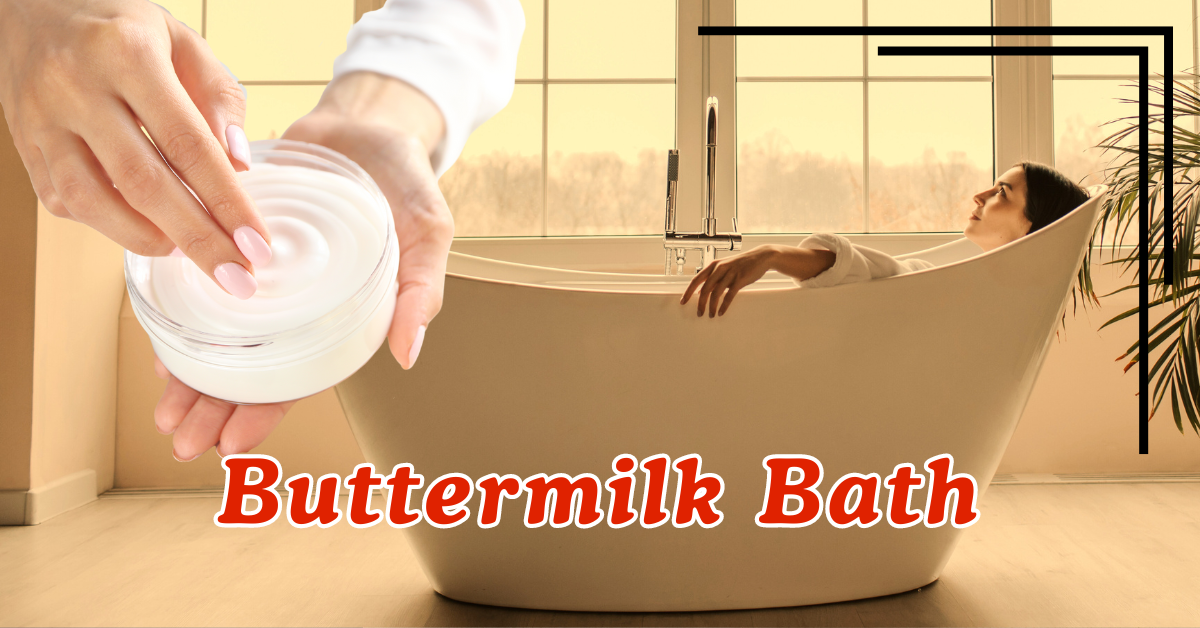Buttermilk baths have been used for centuries as a natural remedy to soothe and rejuvenate the skin. Rich in lactic acid, vitamins, and natural fats, a buttermilk bath provides hydration, exfoliation, and nourishment that help transform your skin’s texture and tone. In this guide, we’ll explore the benefits, easy recipes, and everything you need to know about incorporating a buttermilk bath into your skincare routine.
What is a Buttermilk Bath?
A buttermilk bath is a simple yet powerful skincare practice where you soak in a bath infused with buttermilk. The lactic acid in buttermilk gently exfoliates the skin, while its vitamins and fats provide deep nourishment and hydration. It’s ideal for people with sensitive, dry, or irritated skin.
The Origins of Buttermilk Bathing
The tradition of using milk for skincare dates back to ancient civilizations like Egypt, where Cleopatra was said to have bathed in sour milk to maintain her legendary beauty. The use of buttermilk specifically has grown over time due to its unique benefits, offering more moisture and exfoliation compared to regular milk.
What Makes Buttermilk Good for Your Skin?
Buttermilk is packed with lactic acid, a natural alpha hydroxy acid (AHA) that helps exfoliate dead skin cells. This promotes smoother, brighter skin. The rich fats in buttermilk also lock in moisture, making it an ideal treatment for dry and flaky skin.
Buttermilk Bath Benefits: Why You Should Try It Today
There are many reasons why a buttermilk bath should become a part of your skincare regimen. Here are some of the most compelling benefits:
How Buttermilk Helps in Skin Hydration
The natural fats in buttermilk create a moisturizing barrier that keeps your skin hydrated long after you leave the bath. If you struggle with dry patches or dehydrated skin, regular buttermilk baths can help replenish moisture levels and restore softness.
Buttermilk Bath for Eczema and Sensitive Skin Relief
Buttermilk’s gentle, soothing properties make it an effective remedy for people suffering from eczema and other skin sensitivities. The proteins and fats help reduce inflammation and itching, providing relief for those with irritated skin.
How to Make a Buttermilk Bath at Home
Making a buttermilk bath is incredibly easy and requires only a few simple ingredients. Follow this recipe for a luxurious, skin-nourishing bath experience.
Simple Buttermilk Bath Recipe for Soft Skin
Ingredients:
- 2-3 cups of buttermilk
- Warm water
- Optional: A few drops of essential oils (like lavender for relaxation)
Instructions:
- Fill your bathtub with warm water.
- Slowly pour the buttermilk into the tub, stirring to mix it evenly with the water.
- Soak for 20-30 minutes, allowing the lactic acid and fats to work their magic on your skin.
Variations for Different Skin Types
- For Oily Skin: Add a few tablespoons of baking soda to balance excess oils.
- For Dry Skin: Mix in a tablespoon of honey or oatmeal for extra moisture.
Buttermilk Bath vs Milk Bath: What’s the Difference?
While both buttermilk and regular milk baths are beneficial for the skin, they offer slightly different properties.
Which Bath is Better for Your Skin Type?
Buttermilk is richer in lactic acid than regular milk, making it a better exfoliant for people with dull or uneven skin texture. Milk baths, on the other hand, are ideal for gentle hydration and are often recommended for those with normal to combination skin.
Comparing Benefits of Buttermilk and Milk Baths
- Exfoliation: Buttermilk’s lactic acid content provides deeper exfoliation than regular milk.
- Moisturization: Both buttermilk and milk baths offer moisturizing benefits, but buttermilk’s fat content makes it slightly more hydrating for dry skin.
The Best Times to Use a Buttermilk Bath
A buttermilk bath is not just a luxurious treat; it can be a remedy for a variety of skin conditions.
Buttermilk Bath for Sunburn Relief
Buttermilk’s cooling properties are perfect for soothing sunburned skin. The lactic acid helps reduce inflammation while the fats moisturize dry, peeling skin. Soaking in a buttermilk bath for 15-20 minutes can bring instant relief.
Buttermilk Bath for Dry, Itchy Skin
If you suffer from chronic dryness or itchiness, particularly during the colder months, a buttermilk bath can provide the hydration your skin needs. Regular baths can help to restore the skin’s natural moisture barrier, leaving it smooth and itch-free.
Can You Make a Homemade Buttermilk Bath?
Yes, you can create your own buttermilk bath solution at home with minimal ingredients. It’s cost-effective and allows you to tailor the recipe to your skin’s specific needs.
Tips for Making Buttermilk Bath Products at Home
- Store-Bought vs Homemade: You can buy store-bought buttermilk or make your own by adding a tablespoon of lemon juice or vinegar to a cup of milk and letting it sit for 10 minutes.
- Customize Your Bath: Add essential oils like lavender or chamomile to enhance the relaxing and healing properties of your bath.
How to Store and Use Homemade Buttermilk Bath Solutions
If you make a large batch of homemade buttermilk bath products, store them in a glass container in the refrigerator for up to a week. Always shake the container before pouring it into your bath to ensure all the ingredients are well-mixed.
Enhancing Your Buttermilk Bath: Add-Ons for Extra Benefits
While a traditional buttermilk bath is already packed with skin benefits, you can elevate the experience by incorporating other natural ingredients. These add-ons not only improve the therapeutic qualities of your bath but also provide targeted solutions for specific skin concerns.
Buttermilk Bath with Oatmeal for Extra Soothing
Oatmeal is known for its calming properties, especially for irritated or sensitive skin. When added to a buttermilk bath, oatmeal helps to soothe inflamed skin conditions such as eczema, psoriasis, or sunburn. The natural starches in oatmeal form a protective barrier on the skin, locking in moisture and providing relief from itching.
How to Add Oatmeal:
- Blend 1 cup of colloidal oatmeal into a fine powder and mix it with the buttermilk before pouring into the bath. This ensures an even distribution in the water and enhances the soothing effects.
Buttermilk Bath with Honey for Deep Moisturization
Honey is a natural humectant, meaning it draws moisture into the skin. Adding honey to your buttermilk bath enhances the moisturizing effects, leaving your skin soft and supple. Additionally, honey has antibacterial properties, which can help in clearing up minor skin irritations or breakouts.
How to Add Honey:
- Dissolve 2 tablespoons of raw honey in warm water before adding it to the buttermilk bath. Make sure the honey is fully dissolved to prevent it from clumping.
Buttermilk Bath with Essential Oils for Relaxation
To make your buttermilk bath a complete spa-like experience, you can add essential oils known for their calming and aromatic properties. Lavender oil is particularly beneficial for relaxation, while tea tree oil can offer antibacterial and antifungal properties that help with acne or skin infections.
How to Add Essential Oils:
- Add 5-10 drops of your preferred essential oil to the bath along with the buttermilk. Stir the water well to ensure the oils are distributed evenly. Be cautious with the amount, as too much essential oil can irritate sensitive skin.
Who Should Avoid a Buttermilk Bath?
While buttermilk baths offer a range of benefits, they might not be suitable for everyone.
People with Dairy Allergies
Since buttermilk is a dairy product, those with lactose intolerance or dairy allergies should avoid direct skin contact with buttermilk. In such cases, an oatmeal or baking soda bath may be a better alternative for soothing the skin without causing an allergic reaction.
People with Open Wounds or Infections
If you have open cuts, wounds, or infections, it’s best to avoid a buttermilk bath until they heal. The lactic acid in buttermilk can irritate open skin and may cause discomfort or slow down the healing process. Opt for gentler alternatives like plain water or saline baths until your skin is fully recovered.
For more exciting blogs, visit our homepage Magzineco.
Buttermilk Bath FAQs
How Often Should You Take a Buttermilk Bath?
You can take a buttermilk bath 2-3 times a week, depending on your skin type. If your skin is particularly dry or irritated, you may benefit from more frequent soaks.
Can a Buttermilk Bath Help with Acne or Breakouts?
Yes, the lactic acid in buttermilk can help exfoliate dead skin cells and reduce breakouts. However, it’s important to avoid hot water, as it can exacerbate acne.
Is a Buttermilk Bath Safe for All Skin Types?
Generally, buttermilk baths are safe for all skin types, including sensitive skin. If you have allergies to dairy, you may want to test a small area first to ensure there’s no adverse reaction.
Can I Use Buttermilk Bath for My Child’s Skin?
Yes, buttermilk baths are gentle enough for children and can help soothe conditions like eczema or dry skin.
How Long Should I Soak in a Buttermilk Bath?
A 20-30 minute soak is ideal for reaping the full benefits of a buttermilk bath. Avoid staying in the bath too long, as prolonged soaking can dry out your skin.
Conclusion
A buttermilk bath is a luxurious and effective way to improve your skin’s texture, hydration, and overall health. From soothing dry skin to helping with conditions like eczema and sunburn, buttermilk baths offer a natural solution to many skincare concerns. With the added benefit of being easy to prepare at home, it’s a simple yet powerful addition to any skincare routine. Give it a try, and you’ll soon see why this ancient remedy remains a popular choice for glowing, healthy skin.



